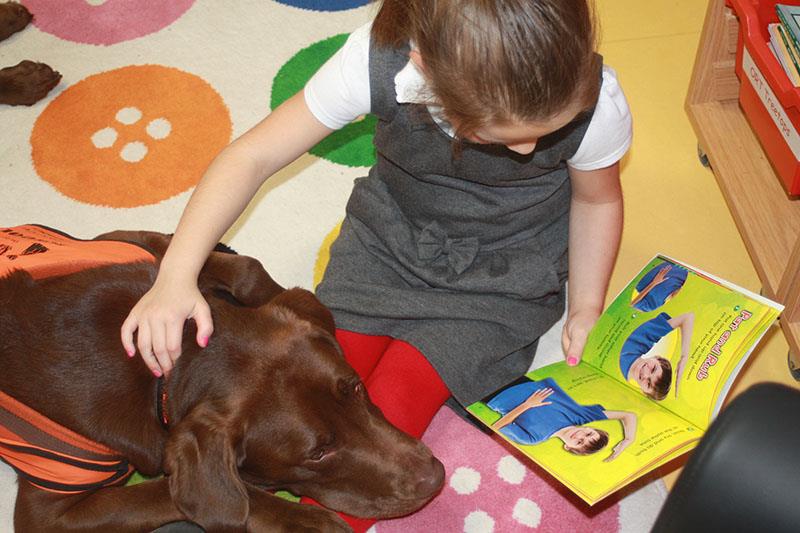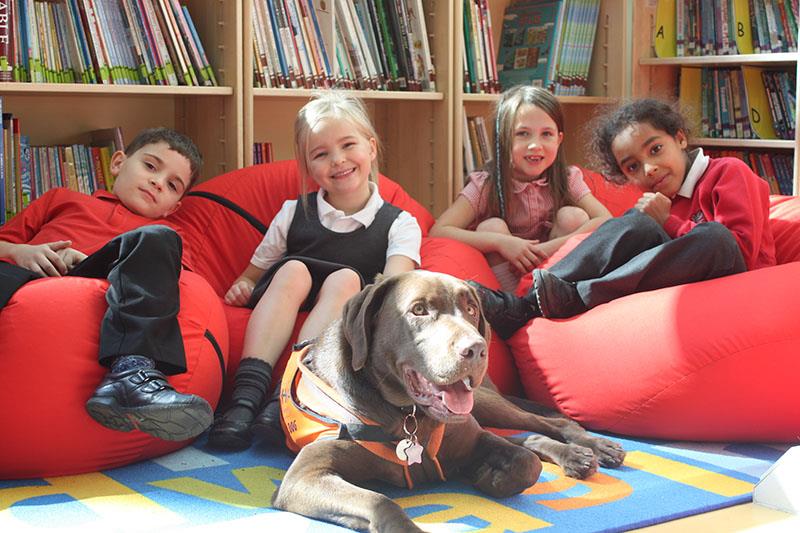There have been recent articles in the media about dogs working in schools as put forward by the education secretary Damian Hinds and Sir Anthony Seldon (BBC, March 2019). This has raised the profile of dogs attending schools and has rightly highlighted that there are many benefits to having a dog as part of the school team.
I am headteacher at Winford CE Primary School in north Somerset, a single form entry primary school located in a semi-rural area just outside Bristol – and we have a school dog.
I started looking for a puppy to bring to school back in 2013 as I was aware of the impact that a dog can bring. After much research, I selected and worked very closely with the charity Dogs Helping Kids, a unique charity that specialises in training dogs for the educational arena.
I was attracted to them because their vision statement states that they want to help teach children non-violence, empathy, respect, kindness, love, responsibility, friendship and trust using dogs. This was a perfect match to our school values.
Fernie, our school dog is a chocolate-coloured Labrador and was chosen after carefully studying characteristics of various breed types and then researching a suitable breeder.
After a three-year training programme with Dogs Helping Kids, Fernie and I undertook eight increasingly difficult assessments, then Fernie was officially certified to work in school. Not only was Fernie well trained, but I learned so much along the way about how to train a dog using only positive reinforcement, how to read the subtlest of Fernie’s body language, and how to ensure that his welfare was paramount. Naturally, we have in place a policy and risk assessment which places equal emphasis on the risks and control measures for the dog as well as for the children.
Now he is six-years-old and comes to work with me most days. He works in various ways in school. For a small targeted number of children, he listens to readers. For this, he has been trained to snuggle and settle his chin on the lap of the child while I take a back seat in the room. The few minutes of reading then allow a special time between the child and Fernie, where they read a few pages of their current book.


Fernie also works on occasions with individual children who need just a few minutes to see, stroke and be calm with Fernie. These are untimetabled moments and just happen as and when needed. Similarly, when I need to have a conversation with a child, doing some work with Fernie is often a non-threatening way in to that conversation.
I also do a lot of work with small groups of children, both on our daily walk around the village, but also in the school hall teaching children to train a dog. This is a wonderful way to boost confidence and those with dogs at home learn how to train using only consistent and positive methods. Our village walk is also a great opportunity to simply chat with the children and to get to know them. Fernie also comes into each assembly and settles on his dedicated mat in his favourite sunny spot.
We work with the whole school through assemblies, posters and constant modelling of how to approach a dog in a calm and non-threatening way, how to read basic dog body language and how to be respectful of animals and their needs. Children all know many of the dos and don’ts of how to be around our four-legged friends. It has become a way of life for us at Winford that weaves its way through everything. We have a whole school of children now that have never known their school without the presence of a dog. Of course I cannot deny that on top of all the benefits for the children, school and community, he is a great support for me. Being a headteacher can be a lonely job and having Fernie there is a great stress-buster for us adults too.
Dogs Helping Kids stipulates that only the owner/trainer can work the dog in school rather than letting others do this. This means that only I can work with Fernie and children, but this ensures that I keep my feet on the ground and have lots of excuses to leave the office and have a direct impact on our children.
At present, there is no legislation and no national standards for dogs in schools. A dog is a fantastic and valuable addition to a school, but only if it is done carefully, a knowledgeable owner and with the dog’s needs as a priority. The recent press attention means well, but has much wider implications.
Dogs Helping Kids is increasingly worried about the huge increase in pet dogs and puppies being taken into schools by staff – and by charities who only provide a basic assessment and one which is not in the school environment.
Dogs are sentient beings with complex emotional needs, and if a dog is simply taken in without any prior training or assessment, it can prove to be a very stressful environment for that dog to be in. If this is compounded by children and adults who have very little idea of how to treat and be around a dog, through naïvety and lack of education, this could be disastrous. A school environment is a busy, noisy, ever-changing environment and any dog needs to be carefully acclimatised and trained so that school is its second home.
Unfortunately, a number of dogs have now bitten children in schools, and each time the dog in question has sadly been put to sleep. Many dogs are being treated like a toy, dogs are being kept in crates in a classroom all day, and puppies are being handled inappropriately, which could lead to a long-lasting trauma.
So as you can see, so much has to be put in place before a dog even starts in a school, and this process can and should take a long time. However, if done properly, dogs in schools can have the most amazing and life-changing impact on children.
- Nik Gardner is headteacher of Winford CE Primary School in north Somerset.
Further information & resources
- Every school ‘needs dog as stress-buster’, BBC, March 2019: https://bbc.in/2Zd76F7
- In order to start thinking about taking a dog into a school, Dogs Helping Kids has worked together with charity Dogs for Good to produce a guidance document for schools: http://bit.ly/2GjJpSX
- The Kennel Club has also worked with a number of dog charities to write a set of suggested standards for dogs in schools. This can be found at http://bit.ly/2VKmlU4
